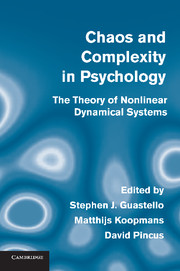Book contents
- Frontmatter
- Contents
- Contributors
- Preface
- 1 Introduction to Nonlinear Dynamics and Complexity
- 2 Collective Intelligence: Observations and Models
- 3 Neurodynamics and Electrocortical Activity
- 4 Psychophysics
- 5 Temporal and Spatial Patterns in Perceptual Behavior: Implications for Dynamical Structure
- 6 Embodied and Embedded: The Dynamics of Extracting Perceptual Visual Invariants
- 7 Origins of Order in Cognitive Activity
- 8 Nonlinear Complex Dynamical Systems in Developmental Psychology
- 9 Developmental Psychopathology: Maladaptive and Adaptive Attractors in Children's Close Relationships
- 10 Psychopathology
- 11 Coherence, Complexity, and Information Flow: Self-Organizing Processes in Psychotherapy
- 12 The Dynamics of Human Experience: Fundamentals of Dynamical Social Psychology
- 13 Group Dynamics: Adaptation, Coordination, and the Emergence of Leaders
- 14 Organizational Psychology
- 15 Complexity, Evolution, and Organizational Behavior
- 16 Agent-Based Modeling Within a Dynamic Network
- 17 Epilogue: Psychology at the Edge of Chaos
- Index
3 - Neurodynamics and Electrocortical Activity
Published online by Cambridge University Press: 18 December 2013
- Frontmatter
- Contents
- Contributors
- Preface
- 1 Introduction to Nonlinear Dynamics and Complexity
- 2 Collective Intelligence: Observations and Models
- 3 Neurodynamics and Electrocortical Activity
- 4 Psychophysics
- 5 Temporal and Spatial Patterns in Perceptual Behavior: Implications for Dynamical Structure
- 6 Embodied and Embedded: The Dynamics of Extracting Perceptual Visual Invariants
- 7 Origins of Order in Cognitive Activity
- 8 Nonlinear Complex Dynamical Systems in Developmental Psychology
- 9 Developmental Psychopathology: Maladaptive and Adaptive Attractors in Children's Close Relationships
- 10 Psychopathology
- 11 Coherence, Complexity, and Information Flow: Self-Organizing Processes in Psychotherapy
- 12 The Dynamics of Human Experience: Fundamentals of Dynamical Social Psychology
- 13 Group Dynamics: Adaptation, Coordination, and the Emergence of Leaders
- 14 Organizational Psychology
- 15 Complexity, Evolution, and Organizational Behavior
- 16 Agent-Based Modeling Within a Dynamic Network
- 17 Epilogue: Psychology at the Edge of Chaos
- Index
Summary
Introduction
In the past two decades, a great deal of attention has been devoted to possible descriptions of electroencephalogram (EEG) activity in the context of chaos – that is, in terms of hypothetical underlying low-dimensional nonlinear dynamics, where trajectories that are initially close together diverge exponentially in time. This assumption is justified by neuron-synchronous firing and by the instability of EEG even to weak attentive stimuli. Moreover, Hebbian synaptic reinforcement implies that parallel synchronization should increase as a basic mechanism for perception and memory. The observed low dimension provides justification for the use of moderately populated artificial neural networks of low computational cost. Artificial neural networks are suitable to determine, or to reproduce, EEG rhythms on a macroscopic scale but are unable to simulate neurophysiological functions. In contrast, clusters of very few neurons, described by nonlinear differential systems that are highly expensive computationally, can realistically reproduce action potential generation and propagation mechanisms. The resulting electric signal traffic, crossing the brain, is sensitive to the electromagnetic (EM) perturbation, which can even alter functional correlates. This property legitimates transcranial magnetic stimulation (TMS) as a research tool to study aspects of human brain physiology with regard to motor function, vision, language, and brain disorders. TMS is also used in diagnostics and therapy.
Basics of Cortical Activity and EEG
The EEG essentially reflects the underlying electrical activity of the brain cortex.
- Type
- Chapter
- Information
- Chaos and Complexity in PsychologyThe Theory of Nonlinear Dynamical Systems, pp. 73 - 107Publisher: Cambridge University PressPrint publication year: 2008
- 2
- Cited by



